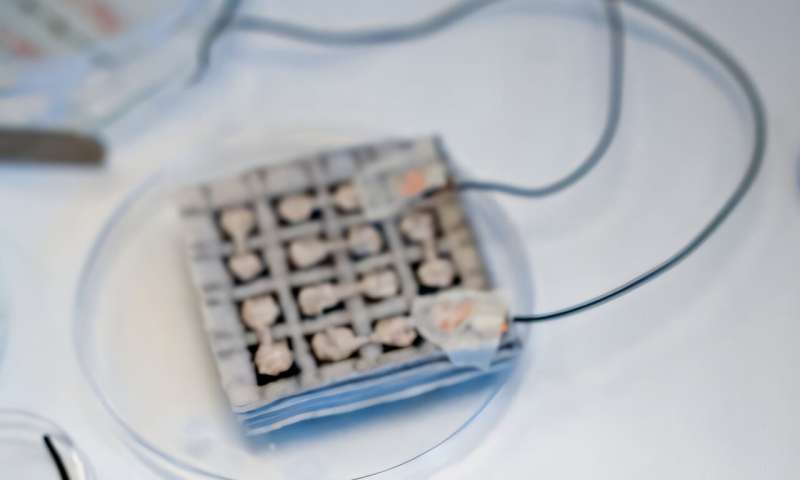The silk thread that can turn clothes into charging stations
Imagine a sweater that powers electronics to monitor your health or charge your mobile phone while running. This development faces challenges because of the lack of materials that both conduct electricity stably and are well suited for textiles. Now a research group, led by Chalmers University of Technology in Sweden, presents an ordinary silk thread, coated with a conductive plastic material, that shows promising properties for turning textiles into electricity generators.
Thermoelectric textiles convert temperature differences, for example between our bodies and the surrounding air, into an electrical potential. This technology can be of great benefit in our everyday lives and in society. Connected to a sensor, the textiles can power these devices without the need for batteries. These sensors can be used to monitor our movements or measure our heartbeat.
Since the textiles must be worn close to the body, the materials used in them must meet high demands on safety and flexibility. The silk thread that the researchers tested has a coating made of a conducting polymer. It is a plastic material with a chemical structure that makes the material electrically conductive and well adapted to textiles.
“The polymers that we use are bendable, lightweight and are easy to use in both liquid and solid form. They are also non-toxic,” says Mariavittoria Craighero, who is a doctoral student at the Department of Chemistry and Chemical Engineering at Chalmers University of Technology, and first author of a recently published study.
The study is published in the journal Advanced Science.
Enhanced stability and conductivity
The method used to make the electrically conductive thread is the same as used in previous studies within the same research project. Previously, the thread contained metals to maintain its stability in contact with air. Since then, advances have been made to manufacture the thread with only organic (carbon-based) polymers. In the current study, the researchers have developed a new type of thread with enhanced electrical conductivity and stability.
“We found the missing piece of the puzzle to make an optimal thread—a type of polymer that had recently been discovered. It has outstanding performance stability in contact with air, while at the same time having a very good ability to conduct electricity. By using polymers, we don’t need any rare earth metals, which are common in electronics,” says Craighero.
To show how the new thread can be used in practice, the researchers manufactured two thermoelectric generators—a button sewn with the thread, and a piece of textile with sewn-in threads. When they placed the thermoelectric textiles between a hot and a cold surface, they could observe how the voltage increased on the measuring instrument. The effect depended on the temperature difference and the amount of conductive material in the textile.
-

Credit: Chalmers University of Technology
-

Credit: Chalmers University of Technology
As an example, the larger piece of fabric showed about 6 millivolts at a temperature difference of 30 degrees Celsius. In combination with a voltage converter, it could theoretically be used to charge portable electronics via a USB connector. The researchers have also been able to show that the thread’s performance is maintained for at least a year. It is also machine washable.
“After seven washes, the thread retained two-thirds of its conducting properties. This is a very good result, although it needs to be improved significantly before it becomes commercially interesting,” says Craighero.
Can meet functions that these textiles require
The thermoelectric fabric and button cannot be produced efficiently outside the lab environment today. The material must be made and sewn in by hand, which is time-consuming. Just sewing it into the demonstrated fabric required four days of needlework. But the researchers see that the new thread has great potential and that it would be possible to develop an automated process and scale up.
“We have now shown that it is possible to produce conductive organic materials that can meet the functions and properties that these textiles require. This is an important step forward. There are fantastic opportunities in thermoelectric textiles and this research can be of great benefit to society,” says Christian Müller, Professor at the Department of Chemistry and Chemical Engineering at Chalmers University of Technology and research leader of the study.
More information:
Mariavittoria Craighero et al, Poly(benzodifurandione) Coated Silk Yarn for Thermoelectric Textiles, Advanced Science (2024). DOI: 10.1002/advs.202406770
Chalmers University of Technology
Citation:
The silk thread that can turn clothes into charging stations (2024, October 31)
retrieved 1 November 2024
from https://techxplore.com/news/2024-10-silk-thread-stations.html
This document is subject to copyright. Apart from any fair dealing for the purpose of private study or research, no
part may be reproduced without the written permission. The content is provided for information purposes only.

Comments are closed